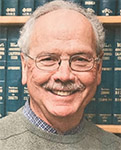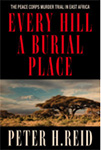IN EVERY HILL A BURIAL PLACE — Publishers Weekly talks with Peter H. Reid (Tanzania)
by Lenny Picker
Publishers Weekly Jul 24, 2020

Peter Reid
In Every Hill a Burial Place: The Peace Corps Murder Trial in East Africa (Univ. of Kentucky, Sept.), [Peter] Reid revisits a 1966 murder in Tanzania that rocked the program. Both Peace Corps volunteers involved—Bill Kinsey, who was accused of murdering his wife, Peppy—were white. What role did race play in the investigation and trial?
There was an interesting dynamic in Tanzania at the time. The country had recently thrown off the chains of European colonialism and was working hard to show its independence and the power of the African leadership. These factors played into the case. There were few African lawyers and even fewer judges. The defense attorneys, expert witnesses, and the judge were almost all white, and all had far more experience than the Africans on the prosecution side. I’m not sure the case demonstrates so much white privilege as the fact that the prosecution was severely overmatched.
Do you believe Bill murdered Peppy?
As the judge found, it was a very close case. On balance, it seems to me unlikely that Bill would have killed Peppy. The police were slipshod in protecting the evidence. When Bill fell while trying to carry Peppy for help, he probably disturbed various items from their picnic, as well as the bloodstained metal bar and rocks found at the scene. Apparently, the bar and the rocks were transported in the back of the police Land Rover, which had blood on the floor. Later on, the defense pathologist tried to recreate Peppy’s injuries on cadavers in Nairobi and couldn’t. Defense medical evidence also demonstrated that the rod didn’t fit her injuries.
Given your own experience in the Peace Corps, were you surprised by how the organization handled the case?
No. It was a difficult situation for the Peace Corps, and they seemed to walk a fine line to appear neutral. From the standpoint of the Peace Corps dealing with a complex international situation, I think the staff did an outstanding job of assembling information, acting quickly, and dealing with all sides.
How did you recreate the trial, since you couldn’t get a transcript?
I had to piece together information from the preliminary hearing, notes, government cables, the judge’s decision, and newspaper accounts. A second problem was the difficulty in tracking down Peace Corps files. When I submitted a FOIA request, I received mostly newspaper clippings. However, I managed to track down John Coyne, who considered writing a book about the case, and who had requested the files many years before and obtained copious, varied materials. He supplied the files to me.
Publishers Weekly Review
Every Hill a Burial Place: The Peace Corps Murder Trial in East Africa
Peter H. Reid. niv. Press of Kentucky, $36.95 (320p) ISBN 978-0-813179-98-8
 Retired public defender Reid (Tanzania 1964-66) offers the definitive look at a now-obscure 1960s murder trial that threatened the future of the Peace Corps. In 1966, Bill Kinsey became the first program volunteer to be accused of murder after his wife, Peppy, died from head wounds while the two were serving in Tanzania. Bill claimed that Peppy had fallen from a hill, but witnesses said they’d seen the couple fighting before her death, and a blood-stained iron bar and stones were found nearby. Bill was supposed to be afforded the same legal protections as an ordinary citizen of the country, but the prosecution was overmatched by the experienced, mostly white defense team that his family arranged, which got him acquitted. During the case, Bill’s arrest and confinement led Tanzania’s leaders to fear that the U.S. might launch a rescue mission. Reid, who served as a Peace Corps volunteer in Tanzania at the time of the trial, notes problems with both the prosecution and defense cases, leaving doubt as to whether justice was served. Beyond that question, Reid does a thorough job of surveying the dilemma the Peace Corps found itself in over whether it should take sides, and if so, on behalf of which volunteer. While the Peace Corps presented a neutral position to the public, Reid suggests officials seemed to do everything to support Bill’s case and little to examine Peppy’s side of things. This is an excellent complement to Philip Weiss’s account of a different murder case, American Taboo: A Murder in the Peace Corps. (Sept.)
Retired public defender Reid (Tanzania 1964-66) offers the definitive look at a now-obscure 1960s murder trial that threatened the future of the Peace Corps. In 1966, Bill Kinsey became the first program volunteer to be accused of murder after his wife, Peppy, died from head wounds while the two were serving in Tanzania. Bill claimed that Peppy had fallen from a hill, but witnesses said they’d seen the couple fighting before her death, and a blood-stained iron bar and stones were found nearby. Bill was supposed to be afforded the same legal protections as an ordinary citizen of the country, but the prosecution was overmatched by the experienced, mostly white defense team that his family arranged, which got him acquitted. During the case, Bill’s arrest and confinement led Tanzania’s leaders to fear that the U.S. might launch a rescue mission. Reid, who served as a Peace Corps volunteer in Tanzania at the time of the trial, notes problems with both the prosecution and defense cases, leaving doubt as to whether justice was served. Beyond that question, Reid does a thorough job of surveying the dilemma the Peace Corps found itself in over whether it should take sides, and if so, on behalf of which volunteer. While the Peace Corps presented a neutral position to the public, Reid suggests officials seemed to do everything to support Bill’s case and little to examine Peppy’s side of things. This is an excellent complement to Philip Weiss’s account of a different murder case, American Taboo: A Murder in the Peace Corps. (Sept.)
Can’t wait to read it. Does the author find out what happened to Bill Kinsey once he is acquitted and returns to the USA? Whether guilty or innocent, this would have such an impact on a life. The true story reminds me a bit of the novel, Long Ago and Far Away by John Coyne.